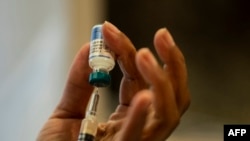Measles is making a comeback in the United States.
Fifty-eight cases of the highly contagious disease were reported Tuesday by health officials in rural West Texas, while eight cases were confirmed in neighboring eastern New Mexico.
Texas officials say the outbreak there, the largest in almost 30 years, is mainly confined to Gaines County, with 45 infections, but four other counties account for an additional 13 cases.
The Texas measles cases, according to health officials, have occurred mainly among a "close-knit, undervaccinated" Mennonite community.
Authorities say at least three of the New Mexico cases are in counties that border Texas' Gaines County.
Earlier this month, the U.S. Centers for Disease Control and Prevention reported 14 measles cases across the country.
Mayo Clinic describes measles as "a childhood infection caused by a virus. Once quite common, measles can now almost always be prevented with a vaccine ... measles spreads easily and can be serious, and even fatal, for small children."
Measles is a respiratory virus that can survive in the air for two hours. As many as nine out of 10 people who are susceptible will get the virus if exposed, according to the CDC.
However, in recent years, the necessity and safety of the vaccinations designed to prevent the disease have come under question, with some parents citing a now-discredited study that linked the measles vaccine to autism.
Another unfortunate development in the fight against measles happened during the COVID-19 pandemic when many children missed their vaccinations. Los Angeles Cedars Sinai said in a statement in February 2024 that 61 million fewer doses of the measles vaccine were distributed nationwide from 2020 to 2022.
Before the MMR vaccination, which addresses not only measles, but also mumps and rubella, was introduced in the U.S. in 1963, there were 3 million to 4 million measles cases every year.
Now there are usually fewer than 200 cases per year, but pockets of measles persist in areas that still resist the vaccinations. The shots are first given to toddlers between 12 and 15 months and then again at 4 to 6 years of age.








